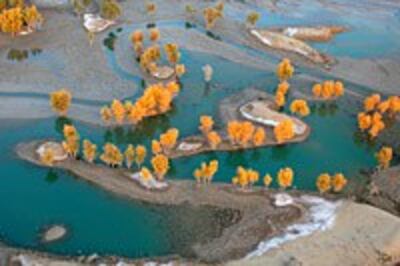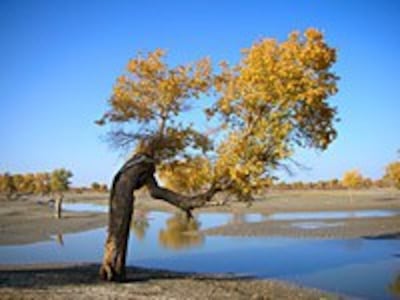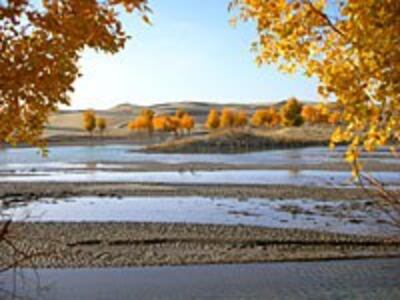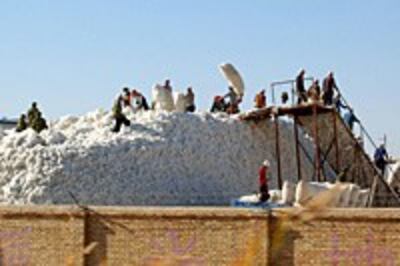
Chinese authorities in the northwestern region of Xinjiang are relocating hundreds of ethnic minority farming families along the dwindling Tarim River. And the families blame major Han Chinese farming and industrial complexes for depleting upstream waters.
By 2008, more than 6,000 households along the river will have been resettled and cultivation forbidden along the river banks, in an attempt to save 60 million cubic meters (16 billion gallons) of water, an official with the Tarim River Valley Administration told local media.
“There is no water in the Tarim River now,” one farmer along the river told RFA’s Uyghur service. “It happened recently. Some time ago for example, the environment was so much better.”

“We could even catch fish right away in the water there. Now there is nothing like that. There’s not even any water,” he said, adding that land around the river had deteriorated so badly that the only viable crop was cotton.
In the current wave of relocations, more than 700 families on land reclaimed from the Tarim River are being moved to farmland near Yuli county, about an hour south of Korla, the official Xinhua news agency reported.
Farmers pointed to intensive irrigation and farming methods in the upper reaches of the 1,321-km river, carried out by China's quasi-military Xinjiang Construction and Production Corps, or bingtuan.
“In the Corps area they spread fertilizers by aircraft,” one farmer from the Muslim Uyghur ethnic group said. “I have been to Corps No. 12. They irrigate cotton by damming the river water. They spread seed by aircraft when they sow rice.”
He said the lack of water had already caused widespread problems in downstream areas like the Baghrash Lake.
There is no water in the Tarim River now. It happened recently. Some time ago for example, the environment was so much better,

“The government investigated this problem and said they would reconstruct the Tarim River ecologically. And they have arranged some things. But it has not come here yet,” he said.
A locally based bingtuan official confirmed the farmers' accounts.
“I am a cadre in this corps and responsible for this station. Corps No. 6 also belongs to the Tarim basin. But we are located in the upper stream…We mainly irrigate our fields with Tarim water,” the official said.
“The problem is that the middle and upper reaches have used up all the water. And there is nothing left for the lower reaches. It does affect the farmers in the lower reaches,” he said.
The problem is that the middle and upper reaches have used up all the water. And there is nothing left for the lower reaches. It does affect the farmers in the lower reaches,
“I think the government should coordinate with certain policies. Maybe via taxation, or some other charges. It really is a kind of paradox. I do not know how to solve this problem myself,” he said, adding that water was akin to money in arid Xinjiang, and that living standards had risen rapidly among the Corps workers.

“The government is working on the reconstruction of the Tarim basin, and on water conservation campaigns. We used to grow only high water-consumption crops like vegetables and fruits. Now we also grow crops like wheat and cotton,” the cadre said.
In addition to farming use, the official said that an estimated 300,000 people also drink Tarim river water, with indigenous Uyghur groups mainly clustered in the downstream regions.
“The Corps are settled mainly in the places like the upper reaches of rivers, around lakes where water is abundant in Uyghur region. And this made a big difference in the annual income between Corps peasants and the local peasants,” said the official.
Local estimates put the annual earnings of Uyghur farmers at around 2,000 yuan (U.S.$250), while Corps farmers make 10,000-15,000 yuan (U.S.$1,250-1,870).
The Tarim River once flowed into the saltwater lake of Lop Nur, but that dried up half a century ago.
Since then, large-scale land reclamation along the river has consumed large amounts of water for irrigation, and a further 320 kms of the river had run dry by the early 1970s.
Beijing launched a U.S.$1.3 billion ecological restoration program in 2001. By 2008, more than 6,000 households along the river will have been resettled as part of the bid to restore the river’s ecology, Xinhua said.
Original reporting in Uyghur by Guljekre. RFA Uyghur service director: Dolkun Kamberi. Written and produced for the Web in English by Luisetta Mudie. Edited by Sarah Jackson-Han.
